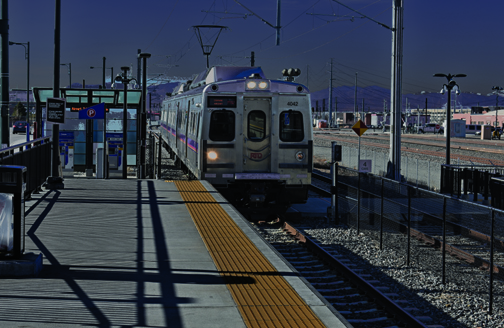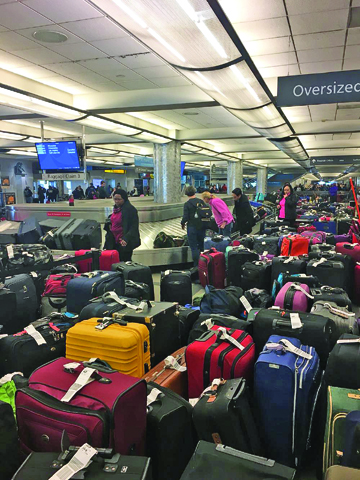‘Train To The Plane’ Terrorizes Neighborhoods
by Mark Smiley

Hellish Nightmare: The A-Line Train To The Plane was to be RTD’s crowning achievement. Instead, it has become the A-Train from Hell for many citizens.
The A-Line train to Denver International Airport (DIA) was supposed to be an exemplary and shining light for RTD’s Light Rail System. However, Front Range citizens were sold a bill of goods in the 2004 election when they approved a tax increase. Voters envisioned a state-of-the-art rapid transit train going from Union Station to DIA. RTD even gave it its highest moniker, The A-Train. But for many citizens of Denver and surrounding communities, it has become the A-Train from Hell.
It has been causing injuries, driving residents from their homes with its loud horns, and has suffered innumerable malfunctions, causing major delays and having passengers miss flights on a regular basis. In fact, the train was struck by lightning twice in 2017 (May and June). The June, 2017 lightning strike forced 81 passengers to be evacuated and walk along a 50-foot-high bridge after a nearly two-hour delay. The entire 23-mile stretch of the A-Line was shut down for close to six hours. Many potential passengers that were relying on this mode of transportation had to find alternative options to the airport.
The reason RTD chose commuter rail over light rail is the ability to run longer stretches of track with fewer stations, travel at speeds up to 80 mph, and have the capacity to transport more passengers. But, the entire system has been a headache for everyone involved since it was launched.
The original plan called for quiet zones but because of countless problems with the crossing technology and switching and signaling, the Federal Railroad Administration (FRA) forced RTD to deploy human beings at each crossing known as the “flag men.” They are stationed at each of the 11 crossings along the A-Line to monitor each train that goes by and ensure automobiles and pedestrians do not cross the track.
RTD pays each flag man $13 per hour and by the time it is all said and done, the total cost of having them at these intersections may come close to $12 million. The flag men are necessary 24 hours per day because of timing glitches on the grade crossings. Part of the timing issue is that the gates are lowered earlier than needed and stay down up to 20 seconds longer than is federally mandated.
The aforementioned quiet zones allow trains to forgo sounding their horns at crossings as long as certain safety measures such as flashers, sturdier railroad gates, upgraded railroad circuitry and raised medians are in place to protect motorists. Up to this

Déjà vu: Many remember the computerized baggage-handling system at DIA and how it was a disaster causing mass chaos and massive delayed luggage retrieval.
point, the FRA has determined that the crossings do not meet these standards. Therefore, the horns must be blown. And, since it started, residents in neighborhoods, such as Park Hill, Clayton and Stapleton, have heard the horns blow almost 340,000 times.
“The Elyria-Swansea and Globeville neighborhoods of Denver have been treated like garbage for generations,” said former Denver City Councilman Ed Thomas. “They have been treated this way for two reasons. Elected officials believe that people that live in those neighborhoods do not matter and they themselves do not live there so they don’t have to live with their decisions.”
This issue has plagued the train since its inception in April 2016. Notwithstanding the fact, that after one year of these glitches which continue to cause delays and scheduling snafus, RTD claims they had solved the problem. Federal regulators signed off on and were satisfied that the timing issues were fixed, bu

Guest Complaints: Guests of the DoubleTree Hotel, which is situated one block from the train tracks, have complained of the loud horns that blare all evening. The hotel offers sound machines, ear plugs, and box fans to help drown out the deafening noise.
t the Colorado Public Utilities Commission did not agree and denied RTD’s certification the same week back in September 2017.
A hearing on this matter is set for March but might be heard as early as February 15, 2018, if there is no objection from the Union Pacific and BNSF railroads. The Colorado Public Utilities Commission administrative law judge Robert Garvey will hear the case and decide whether the gate crossings are operational and safe. If he rules in favor, the flag men can be removed.
These scheduled hearings, and the fact that the A-Line train that has been blasting through neighborhoods for nearly two years, offer little comfort for residents of Park Hill and surrounding neighborhoods.
The sound of loud train horns bellow through otherwise sleepy neighborhoods. The RTD A-Line Train to Denver International Airport blasts through neighborhoods with horn sounds at a federally mandated 96 decibels. That is comparable to a motorcycle revving up a few feet away. The reason for these horns is due to technological glitches that have tainted the “train to the plane.”
Trains cross these intersections nearly 5,000 times per month and blare the horns four times for a total of 20 seconds each time. The deafening horn has neighbors up in arms. “I can’t believe how loud those trains are and I live seven blocks away,” said Julie Buckner. “There is no break from the noise. It’s constant.” Buckner lives seven blocks away but some homes are just 1-1/2 blocks from the crossings.
The DoubleTree Hotel on the north side of Smith Road on Quebec Street is located just one block from the train tracks and guests of the hotel are surprised when they check in and are offered noise machines, ear plugs, and box fans. “I will never stay at this hotel again,” said Joan Kelleher from Flint, Michigan. “The sound of the train echoed through my room all night long. What is the deal?”
Under the Train Horn Rule (49 CFR Part 222), locomotive engineers must begin to sound train horns at least 15 seconds, and no more than 20 seconds, in advance of all public grade crossings. The maximum volume level for the train horn is 110 decibels which is a new requirement.
RTD has the horns sounds close to the maximum allowed decibels and according to a letter sent to The Denver Post, residents can hear it as far as the Montclair neighborhood which is 25 blocks away at 12th Avenue and Elizabeth Street.
Some residents of Denver are having déjà vu as they remember the baggage claim issues at DIA. The computerized baggage-handling system was an unmitigated disaster whi

System Failure: RTD operates the 23-mile stretch of the A-Line train from Union Station to Denver International Airport. Many have been affected by the technological glitches that have plagued this system for nearly two years.
ch caused mass chaos. It was plagued by serious mechanical and software problems that has a ripple effect even today.
When the trains in between concourses broke down the day before Thanksgiving in 2017, people wondered if everything DIA is associated with turns sour. If the bad luck continues, RTD’s A-Line Train To The Plane will be next in a long line of failures associated with the airport.
